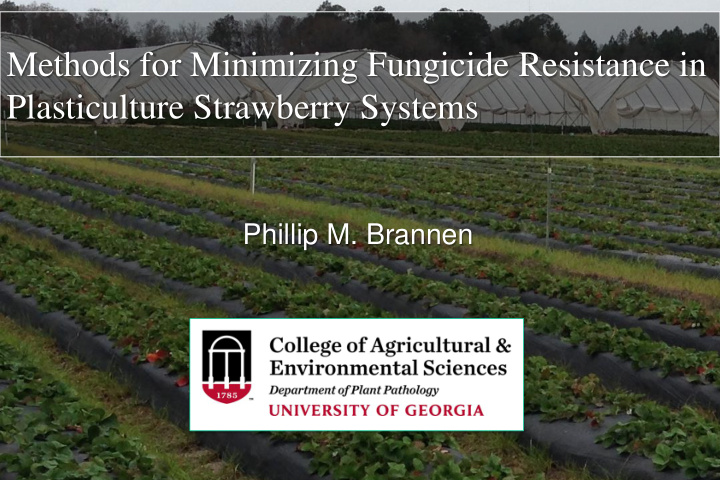



Methods for Minimizing Fungicide Resistance in Plasticulture Strawberry Systems Phillip M. Brannen
Systemic Fungicides Not as systemic as you may think. When fungicide is sprayed on one leaf, it is not readily moved to other unsprayed leaves. Coverage is still very important. Systemic fungicides can move within the xylem (transpiration stream) in a leaf, resulting in more uniform distribution than that achieved by the initial deposit. Principles of Disease Management; Fry (1982)
Principles of Resistance Management Alternating sprays with fungicides from different classes (different modes of action) is an important means of resistance management. Tank-mixing of different fungicides is also an acceptable method of resistance management, and both methods are employed. Many fungicides are limited to a set number of applications per year in order to improve their long-term survival. Follow the label recommendations.
Tank Mixing Fungicides for Resistance Management Good resistance management tool. Do not use half rates of a systemic and a contact, since disease control would be poor and resistance management would be poor (unless known synergy occurs). Contact usually works very quickly, and systemic may have moderately delayed action, so combination is sometimes good. Alternation is a good resistance management scheme, and the cost issue is avoided.
Resistance Management Use the fungicidal rate which results in complete kill or deactivation of the fungus. Reducing rates is a dangerous game, since the end result may be a “training” of resistant strains.
www.frac.info
R = resistant S = sensitive
Evolution of fungicide resistance: quantitative resistance Deising H et al. Brazilian Journal of Microbiology (2008) 39:286-295
Evolution of fungicide resistance: qualitative resistance Deising H et al. Brazilian Journal of Microbiology (2008) 39:286-295
Acero et al. Int. J. Mol. Sci. (2011) 12:795-816
1. Use cultural practices to reduce carryover inoculum.
1. Use cultural practices to reduce carryover inoculum. 2. Bring in clean, disease-free plants.
Phytophthora crown and root rot
Botrytis gray mold
Powdery mildew
1. Use cultural practices to reduce carryover inoculum. 2. Bring in clean, disease-free plants. 3. When possible, use fungicides which are not prone to resistance development, such as Captan and Thiram.
1. Use cultural practices to reduce carryover inoculum. 2. Bring in clean, disease-free plants. 3. When possible, use fungicides which are not prone to resistance development, such as Captan and Thiram. 4. Check the resistance status of your pathogens (when possible).
Collecting gray mold from fruit
No Resistance 1 2 3 4 5 6
High Resistance 1 2 3 4 5 6
Summary Monitoring results from 8 states, 2012 Fludioxonil Switch (fludioxonil) Iprodione Rovral Switch Fenhexamid Elevate Cyprodinil Switch (cyprodinil) Boscalid Pristine (boscalid) Pristine (pyraclostrobin) Pyraclostrobin T-methyl Topsin M 0 20 40 60 80 100 % No resistance Moderate-high risk of resistance
1. Use cultural practices to reduce carryover inoculum. 2. Bring in clean, disease-free plants. 3. When possible, use fungicides which are not prone to resistance development, such as Captan and Thiram. 4. Check the resistance status of your pathogens (when possible). 5. Avoid fungicides which are exceptionally prone to resistance development.
Schnabel and Perez
1. Use cultural practices to reduce carryover inoculum. 2. Bring in clean, disease-free plants. 3. When possible, use fungicides which are not prone to resistance development, such as Captan and Thiram. 4. Check the resistance status of your pathogens (when possible). 5. Avoid fungicides which are exceptionally prone to resistance development. 6. Spray as little as possible.
www.smallfruits.com
Path Forward (1) Continue and expand monitoring for resistance. (2) Incorporate new fungicides with different modes of action, and determine efficacy of other fungicides and combinations. (3) Incorporate novel approaches to management, such as timing sprays.
Recommend
More recommend